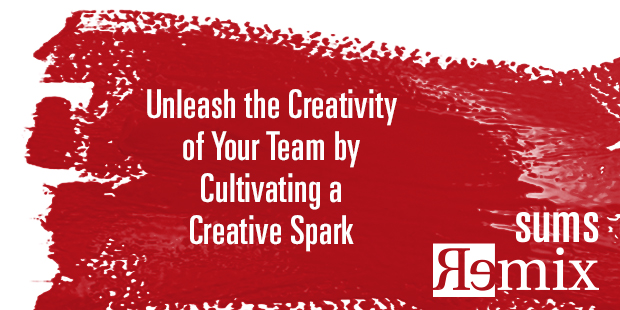
Unleash the Creativity of Your Team by Cultivating a Creative Spark
Below is a weekly series posting content from one of the most innovative content sources in the church world: SUMS Remix Book Summaries for church leaders. SUMS Remix takes a practical problem in the church and looks at it with three solutions; and each solution is taken from a different book. As a church leader you get to scan relevant books based on practical tools and solutions to real ministry problems, not just by the cover of the book. Each post will have the edition number which shows the year and what number it is in the overall sequence. (SUMS provides 26 issues per year, delivered every other week to your inbox).
How can I unleash the creativity of my team?
In our fast-paced digital life, church leadership teams need to be creative in order to deal with the changes coming their way today – or they risk irrelevancy tomorrow.
Creativity then, becomes a constant process for every ministry area of any church rather than an occasional requirement for the worship pastor at Christmas or only limited to those “creative” churches.
Like farmers and their crops, leaders cannot dictate creativity, but they are called to cultivate creativity. Thinking and acting creatively doesn’t just happen because a leader desires it or orders it to happen. With the right environment, resources, mindset, and vision, your team will be able to develop the required motivation to be creative on their own.
If you desire to unleash the creativity of your team, try this:
Solution – Cultivate a creative spark.
THE QUICK SUMMARY – Creative Confidence, Tom and David Kelley
Too often, companies and individuals assume that creativity and innovation are the domain of the “creative types.” But two of the leading experts in innovation, design, and creativity on the planet show us that each and every one of us is creative.
In an incredibly entertaining and inspiring narrative that draws on countless stories from their work at IDEO, the Stanford d.school, and with many of the world’s top companies, David and Tom Kelley identify the principles and strategies that will allow us to tap into our creative potential in our work lives, and in our personal lives, and allow us to innovate in terms of how we approach and solve problems. Creative Confidence can your team be more productive and successful in fulfilling their responsibilities.
A SIMPLE SOLUTION
French chemist Louis Pasteur is quoted as saying “Chance favors the trained mind.” You can lead your team to think the same way, by being prepared to be creative.
Creativity doesn’t happen in a vacuum. Your efforts to encourage your team’s creativity could be as simple as a change in perspective, or as complex as a new working environment. It’s probably going to be somewhere in-between.
The point is, your team’s creativity can be influenced by specific actions you take. Their claim to fame probably won’t be on the same level as discovering the principles of vaccination or pasteurization, but it could be just as meaningful to your organization.
Sometimes, your team just needs a spark to fire up their creativity.
The creative spark needed to come up with new solutions is something you have to cultivate, over and over again. One way to begin is to consciously increase the inspiration you encounter in your daily life.
Effective strategies to help you get from blank page to insight.
- Choose Creativity – To be more creative, the first step is to decide what you want to make it happen.
- Think like a Traveler – Like a visitor to a foreign land, try turning fresh eyes on your surroundings, no matter how mundane or familiar. Don’t wait around for a spark to magically appear. Expose yourself to new ideas and experiences.
- Engage Relaxed Attention – Flashes of insight often come when your mind is relaxed and not focused on completing a specific task, allowing the mind to make new connections between seemingly unrelated ideas.
- Empathize with Your End User – You com up with more innovative ideas when yo better understand the needs and context of the people you are creating solutions for.
- Do Observations in the Field – If you observe others with the skills of an anthropologist, you might discover new opportunities hidden in plain sight.
- Ask Questions, Starting with “Why?” – A series of “why?” questions can brush past surface dtails and get to the heart of the matter.
- Reframe Challenges – Sometimes, the first step toward a great solution is to refram the question. Starting from a different point of view can help you get to the essence of a problem.
- Build a Creative Support Network – Creativity can flow more easily and be more fun when you have others to collaborate with and bounce ideas off.
– Tom Kelley and David Kelley, Creative Confidence
A NEXT STEP
At your next team meeting, review the list of strategies above. Select one activity that you will lead your team in each week. Have each team member note how they are applying the principle individually in a personal creativity journal.
Each week, devote 30 minutes of your team meeting to discussing that week’s strategy.
- How has the strategy worked in improving team creativity?
- What new directions has the strategy unveiled?
- What current activities has the strategy revealed that need to be “stopped”?
- How could the strategy be modified to improve creativity even more?
- How will your team adopt this strategy into their creative cycle, without it getting “stale?”
At the end of the 8-seek experiment, schedule a one-hour meeting with your team to decide and commit on strategies that will become a regular part of their creative process.
At periodic occasions throughout the year, check-in with the team to see how the strategies are working, or if they need to be modified or abandoned.
To learn more about helping your team develop a creative spark, start a conversation with the Auxano team today.
Taken from SUMS Remix 15-1, published May 2015
>> Subscribe to SUMS Remix <<

Tags: Creative Confidence, Creativity, David Kelley, SUMS Remix, Tom Kelley













